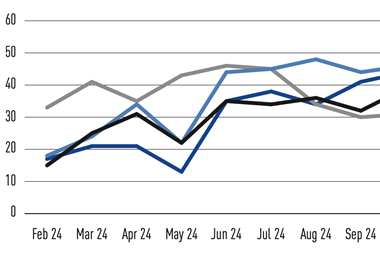Hungary’s headlong rush to sign up to western political and cultural values is disturbingly reflected in the current state of the pensions system. Just as major developed economies such as the UK, France and Germany are facing up to a crisis in the funding of pensions, the demographics of Hungarian society mean the government is faced with a radical overhaul of the payment system.
As in most countries, the post-war baby boom is now producing a larger than usual group of people heading toward pensionable age. In the case of Hungary this has been exacerbated by the policies of 1950s minister for social affairs Anna Ratko, who introduced legislation banning abortion and any kind of family planning. Improved health care has also meant that more people are living well past their retirement age.
Since the mid-1960s, however, with the reversal of the policies of the Ratko era, the Hungarian birth rate has been in steady, inexorable decline. The result is that fewer and fewer workers are supporting an ever-increasing number of pensioners. Analysts predicted in a government review in 1990 that within 20 years state pension fund income would be unable to cope with the social security bill.
More importantly, this view was shared by the World Bank. In its 1990 report on Hungarian loan rating, the bank insisted that Hungary should reform its pension system, and introduce private pensions.
To begin with the government increased the retirement age from 55 for women and 60 for men to 62 for both sexes. A restricted pension for those who could show more than 15 years of contribution to the central pension fund, as opposed to a previous minimum of 20 years, was also introduced. But such provisions, despite temporarily easing the crisis, were never going to be enough.
Consequently after much debate the Gyula Horn government introduced “voluntary” pension funds in 1993. Compulsory private pension funds were launched last year.
The new system will provide private pensions for all by 2020, but until then the state and private pensions will co-exist, and to this end all new entrants into the job market have been paying into private funds since January of last year.
Agnés Beloff, of the ministry for social and family affairs, explains how the new system will operate. “All new employees will pay for a private pension, while those under 30 who began work before 1998 may choose which system they wish to adopt. We would recommend a private pension, although depending upon their age and income it may be worthwhile sticking to the state system.”
Regardless of whether one is paying into the state or a private pension fund, employees may also opt to contribute to a voluntary pension fund. The state encourages the private sector by offering tax breaks to contributors. Up to 50% of the annual payment to a voluntary pension fund can be set off against income tax. The size of the deduction is controlled by age bands imposed by the government, and contributors must be able to pay into the fund for a minimum of 10 years prior to retirement.
Trade unions in Hungary are taking an active interest in the changes; Zoltan Musci explains their recommendations, and fears: “Pensions have been an area of real concern for unions such as our own for a number of years now, as we have seen their value fall dramatically. From our point of view we have to ask, how can our members get the best value for their contribution?”
It is difficult to estimate how much Hungarians are now putting into their private and voluntary funds, but a look at state contributions may give some indication as to what those levels might be. Until this year employers paid 24% of employees’ gross salary into the state pension fund, and a further 3% into the social security health fund. The employees’ contribution was 7% and 3% respectively. This year, however, the government has reduced the employers’ joint contribution by 6% and increased the employee contribution to 8% of gross salary. The increase in the employee contribution is offset by allowing 25% of this amount to be tax-deductible.
Musci points out that the trade unions are actively supporting the transformation to private pensions, and doing so in imaginative ways. “There is a widespread practice in the private and public sector to renounce pay increases in favour of a contribution to a voluntary pension fund. That is to say the wage increase is transformed into a “pension fee” paid by the company into a voluntary fund. The government encourages this by making 50% of this fee tax-deductible. The amount of the fee can be a percentage of salary or a lump sum, depending upon the statutes of the fund,” he explains. “From our point of view we would like contributors to be more actively involved in the funds they contribute to. It is, however, a new culture for most workers, and one they feel unfamiliar with. Nevertheless, we encourage them to get as much information from the fund managers as possible, as they are entitled to do under the law.”
At the moment almost 50 companies are managing pension funds in Hungary, with most of the big local and foreign banks and insurance companies involved. Most analysts agree that, although most funds are stable and strictly controlled by the Central Office for Pension Funds, mergers are likely in the future. “We would certainly expect to see consolidation in the future,” says Cameron Hannah at William M Mercer in Geneva.
He thinks it unlikely that Hungarians are investing more than before in pensions, but confirms that the voluntary funds already have some 1m members, either through company-run schemes, or “open funds” which companies can invest in. “I doubt if we could classify Hungary as a nation of savers yet, but the private and voluntary funds seem to be working well.” Hannah confirms that the funds are investing predominantly in the local bond and equity markets, which only five years ago many felt would be unable to sustain this kind of investment.
Naturally, the main concern for pensioners is the value of their pension, whether private or public, and this is a political hot potato in Hungary at the moment. According to government statistics the average gross monthly salary in Hungary is between Ft60,000–65,000 (e240–260). This means that after deductions take-home pay averages Ft40,000.
At the moment the average pension, which is not taxable, is Ft25,000– 30,000. Naturally, across-the-board averages rarely tell the whole story, and there is no question that workers in some sectors have seen their pensions eroded over the years.
The government, aware of the fall in pension value, and under pressure from the vociferous National Chamber of Pensioners, decided to act last year. As suggested by the NCP, the decision was taken to adopt the Swiss indexing system. Pension increases were to be calculated not only on price increases, but also by taking into account net salary levels. According to this system, pensions should have risen by 20% this year, exceeding the forecast inflation rate and improving their value for the first time in 10 years.
“This was excellent news,” says Peter Gyorge at the NCP. “What is more, the government finally seemed to have some long-term plan for pensions. Under last year’s pensions law in the year 2000 pensions increases would be defined as 70% of net average salary and 30% of a retail price index. In 2002 these proportions would become 50%–50% and in 2014 as 50% of gross average salary and 50% of retail price index. That year, pensions would become taxable.”
Pensioners’ excitement was short-lived, however, as the incoming Orban government abandoned the reforms. This has resulted in a confrontation between the government and 3m pensioners. In theory the government’s position is that there should be no across-the-board increases, and that poorer pensioners should benefit more than wealthier ones. Unfortunately the government has failed to explain how “poorer pensioners” are to be defined, and no-one at the ministry for social and family affairs could explain to IPE whether shorter periods of service, and hence contributions, were taken into consideration.
The result of the policy change was that a small group of pensioners on the minimum Ft15,000 pension received a 25% increase, while the vast majority had to make do with an 11% increase, based on the inflation forecast of 11% for 1999. Furious pensioners’ leaders and trade unions organised a petition in the name of the National Federation of Hungarian Trades Unions, and raised 400,000 signatures. “We are back to a situation where pension values are being eroded once again,” says Gyorge.
The government, meanwhile, maintains that this is a short-term decision for this year, and does not mean that a new indexing system will not be introduced later.












No comments yet